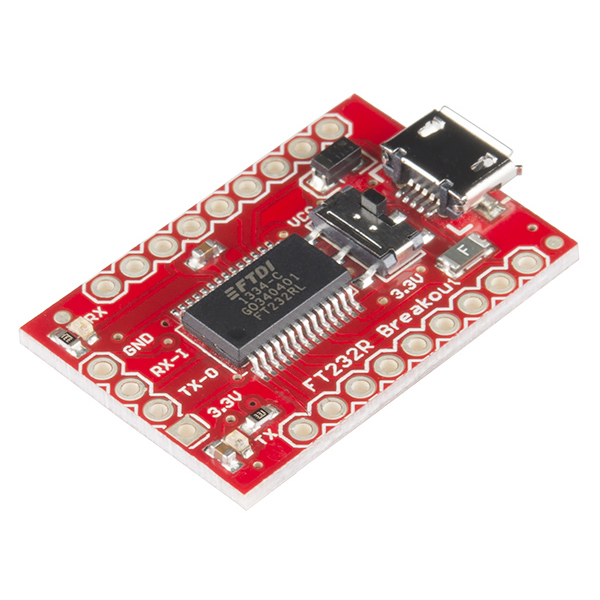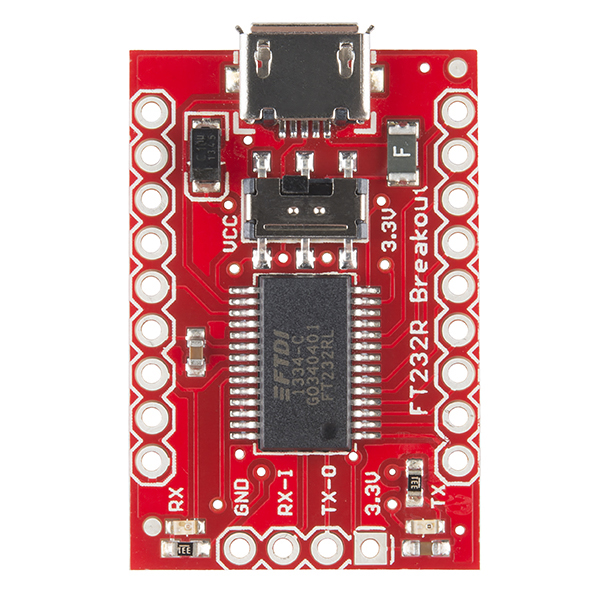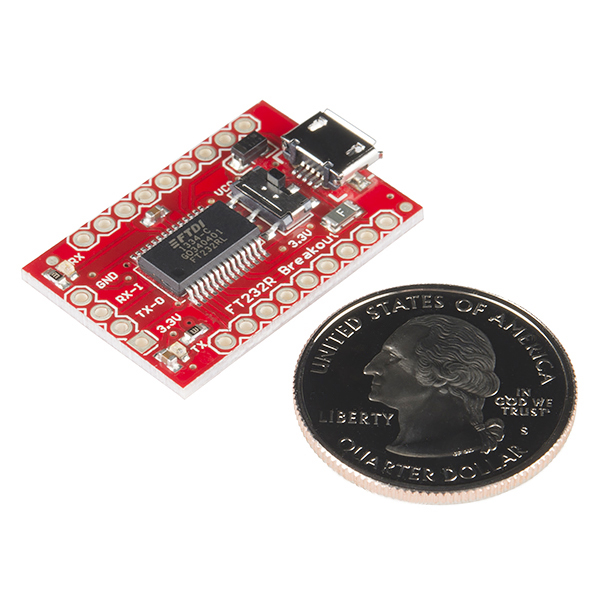SparkFun USB to Serial Breakout - FT232RL
This is the SparkFun USB to Serial Breakout for the FT232RL, a small board with a built in USB to serial UART interface. This little breakout is built around the FT232RL IC from FTDI, with an internal oscillator, EEPROM, and a 28-pin SSOP package this is a serious little chip.
With this version, we've corrected a few issues found with the board. These changes include fixes to the VCCIO, a change from the mini USB to micro USB connector, and a few footprint modifications. Other than finding this board much easier to use, it is still the same FT232RL breakout that you know and love!
- Implements full v2.0 USB protocol
- Needs no external crystal
- Internal EEPROM for device ID and Product Description strings
- Royalty-Free Driver support for Windows, Linux, and Mac OSX
SparkFun USB to Serial Breakout - FT232RL Product Help and Resources
How to Install FTDI Drivers
June 4, 2013
How to install drivers for the FTDI Basic on Windows, Mac OS X, and Linux.
Core Skill: Soldering
This skill defines how difficult the soldering is on a particular product. It might be a couple simple solder joints, or require special reflow tools.
Skill Level: Noob - Some basic soldering is required, but it is limited to a just a few pins, basic through-hole soldering, and couple (if any) polarized components. A basic soldering iron is all you should need.
See all skill levels
Core Skill: Electrical Prototyping
If it requires power, you need to know how much, what all the pins do, and how to hook it up. You may need to reference datasheets, schematics, and know the ins and outs of electronics.
Skill Level: Rookie - You may be required to know a bit more about the component, such as orientation, or how to hook it up, in addition to power requirements. You will need to understand polarized components.
See all skill levels
Comments
Looking for answers to technical questions?
We welcome your comments and suggestions below. However, if you are looking for solutions to technical questions please see our Technical Assistance page.
Customer Reviews
4.4 out of 5
Based on 25 ratings:
1 of 1 found this helpful:
Very useful board.
I use this board to interface with PSoC, Beaglebone, and other devices. It is easy to use and flexible.
2 of 2 found this helpful:
Good, but no 1.8v
Works well, but doesn't seem to support 1.8v even though the IC is capable of it: http://www.ftdichip.com/Products/ICs/FT232R.htm
1 of 1 found this helpful:
Truly useful little board
Very useful for adding a serial port to devices/systems that do not have one, or if you ran out.
Works as advertised and very easy to implement quickly for all sorts of applications.
Make sure you are using the correct FTDI drivers, the default Microsoft drivers will not work and drive you crazy.
5+ stars...
2 of 2 found this helpful:
Great solution for chip comm
I have this board connected directly to an ATMEGA32 chip for debug. It works great, simple to hook up. Uses universal FTDI drivers.
4 of 4 found this helpful:
Works great, could use one feature.....
The board worked perfectly as designed but I had to do one hack first. The I/O voltage is only selectable between 3.3 and 5V while my processor runs at 2.5V. I had to remove the switch and add a provision for an external I/O voltage input. Adding a pad and some sort of jumper, etc. for this would be helpful. Thanks at least for providing the schematic, it made the mod very easy to do.
3 of 3 found this helpful:
Bits go in, bits come out.
There are much cheaper bridges available in bulk from Alibaba and Ebay, but usually they're based on the SiLabs CP2102.
Pros: Dual mode drivers - You can use as VCP or direct mode. Great DLL documentation and source code examples for many platforms. DLLs to go with that great DLL documentation. Respectable support department has been responsive even to my hobby user questions. One set of drivers works with serial, JTAG, FIFO, other variants of the FTDI chips.
Cons: It's a wee big for hobby projects where space is tight. There are some Silabs boards that are 1/2 or 1/3 the size. This board is pretty easy to cut down without worrying about damaging anything though. Price - You can get equivalent function for serial only for $5 or so elsewhere, but you may have the occasional defective card.
Bottom line: FTDI chips are well supported and documented. You get piece of mind that your project will just work - the first time, every time.
1 of 1 found this helpful:
A need to have for any electronic engineer
It is simple and it can still do all you need it to, best thing is it just work. I use it both in teaching my electronic class and development of satellite instrument. At DTU Space Denmark Best Regards Thorbjørn H. Christensen
Works great but...
This product works great but the USB connector has come off of the board on dozens of these boards. I believe that the connectors have weak solder joints. So I reflow the solder joints on these connectors and I haven't had any problems since.
Great job, even it's a pity the lack of 1.8 volts.
Good item at a reasonable price. The bad side regards shipping and custom fees for all those living outside US. In total i spent three times the original cost. May you, Sparkfun guys, activate other more convenient channels for those living in Europe and in Italy as I am? Just now, on Amazon, I found some, but not all, your products. If I could buy them with cheaper additional costs, you would be perfect! Best regards Alessandro
Listening in on another RX/TX
I got two of these so I could tap into the RX/TX of another board to help debug the software there. They worked great!
Functions exactly as expected.
No issues installing driver software or operating the device. Perfectly suited my needs to switch between 5V or 3.3V serial output.
This is a very useful little card.
I'm an amateur radio operator Callsign KF8KT and I do a modification to the RotorEZ card that uses serial port communications. This card allows me to add USB connectivity and it works like a charm. I only have to add two jumpers on the RotorEZ card, wire the breakout board, and add a USB-B female panel mount pigtail on the back plane to it to get it to work. It's pretty simple to do and it's a good upgrade to an already great product.
If you would like to add a neat feature to this breakout board four mounting holes in the corners would be useful. That way computer motherboard mounting hardware could be used to attach the breakout board to the chassis.
Thanks,
Darrell KF8KT
Mod for 1.8V / 2.5V
I lifted the center pin of the switch that supplies VCCIO. VCCIO is still connected to the FT232 and a test pin. I supplied 1.8 to the test pin and it communicates fine with my 1.8V UART. I am sure it would work for 2.5V also.
I've needed this
This USB serial device is the thing I've been looking for. I hooked it up to my Roomba and it just worked. It's full featured so you can do some interesting stuff with it. How many features do you need? How about everything but the JTAG?
annoying loopback echo
I was just plugging it in for a quick test, to make sure drivers install and whatnot. If nothing is connected it automatically echoes (loops back) anything sent. The RX light comes on, so I'm pretty sure it's a hardware thing. I had to connect RX to GND to get it to quit. None of my USB-to-RS-232 adapters do that, nor my Serial Basic CH340 USB-to-UART adapter. Other than that, it plugs in and drivers install. That's all I know right now.
A basic, no frill, but extremely affordable USB to serial I/f
Works as expected for my purpose of programming Atmega328p chips. I use a Mac so I did need to install the driver, but it was fairly straight forward. I plan to use this device regularly, does SparkFun sell enclosures?
It works!
I ordered this to try with an older app called "FT232 SVF Player v1.0" by Openschemes.com. It works fine! The app is slow, though, but it successfully programmed an old Xilinx XC9536 CPLD.
FT232RL Breakout Board is a good one!
This little breakout board came with everything needed to assemble in various configurations to fit your need. The board worked exactly as advertised, and was a snap to set up after assembly. Love the documentation provided at Sparkfun--best in class.
Prrobably eorks ok, if you can get it to work....
Spent two days trying to get this BOB to work as an Arduino UART to PC serial interface with no luck.
Section 7.4 in the FTDI PDF (USB to MCU UART Interface) is pretty self explanatory, but nothing seems to work.
Purchased an ADAFruit serial interface and was up and running in 10 minutes.
A hookup guide would likely resolve my problems, but none to be found.
A MCU hookup guide should be supplied with the documentation.
Avoid headacches and checkout the ADAFruit serial interfaces.
Sorry to hear that the product gave you issues. If you want to file a return ticket we can take the device back for testing and see what the deal is: https://www.sparkfun.com/returns
0 of 3 found this helpful:
USB cable
Beware this does not use a standard USB mini cable. I needed to steal my wifes phone cable to fit.
Board okay but data sheet not...
Board itself works okay but as this is first time I am using this board I had problem finding the correct pin connections to the other board (BT module) I am using in my project. The data sheet available in your page shows all but the simple connection diagram for 2x9 pins + additional 4 pins.
I'm sorry that it wasn't easier to find the information you were looking for. We try to cover as much as we can in our docs, but we can't always get everything. Happy hacking.
Excellent tool!
Everyone who works with microcontrollers and sensors should have at least one of these in their toolbox. It took me 5 minutes to connect this to a sensor and I was up and running.
Great breakout board
Easy to implement. Works great for interfacing UART and USB.
The board works as promised .
Recommended for others
works as it should
nice little pcb works as it should





What does the VCC/3.3v switch do on this board? Since the breakout has VCC and 3.3V pins. What is this switch used for?
it could use some mounting holes
Is the RX pin 5v tolerant? The spec sheet for the FT232RL seems to say yes in a couple places, this? (Would like to use this on a 5v Arduino pro mini without level shifting ... And yes, if your wondering, I am lazy ;) ).
Yes, this is basically the same circuit we use on the FTDI basic which is designed for programming the Pro Mini. This just breaks out more pins. For true laziness I recommend the FTDI Basic which has a pinout to match the Pro Mini.
Can anyone tell me how much current this can handle on the RX pin?
I get that the micro USB is compact, but the pins simply don't last multiple insertions and micro connections are not as mechanically sound (plugs can just fall out on their own).
Bring back the mini USB version and make both available...!!
I would like to understand the design decision behind jp3, pin 1 being 3.3 and not vccio? thanks.
OS X users might want to read this: https://aushacker.wordpress.com/2015/09/18/ftdi-and-os-x/
If this board is ever updated, it would be nice if there was an option for the user to supply VCCIO so this board could interface to 1.8V or 2.5V logic. I guess you might be able to do that with this board by removing the VCCIO switch, but a 3-position switch that allowed for this option without requiring disassembly would be nice even if the LEDs wouldn't work with a lower VCCIO.
Thank you for the feedback! We'll definitely take a look at that the next time this board is up for revision.
Can I use this breakout board with my Robotis Dynamixel MX64T ? To replace this component: http://www.trossenrobotics.com/robotis-bioloid-usb2dynamixel.aspx to drive these motors ? http://www.trossenrobotics.com/p/mx-64t-dynamixel-robot-actuator.aspx
This board won't actually work well for your application. It looks like you need a USB-to-RS232 converter or a USB-to-RS485 converter. This board is USB to serial UART.
Feeling a little lost, can anyone help me with the pin outs to use to program an Arduino Pro Mini?
To program an Arduino Pro Mini you basically need 4-5 connections. The first 2 are power and ground. Assuming nothing else is attached to the Pro Mini you can use either 3.3V or 5V power with no problem. Next is RX and TX. RX is receive and TX is transmit, meaning RX needs to go to TX and TX to RX. Sometimes you will see RX-I or TX-O, the I and O basically mean input or output and you can just ignore them. This tends to be the tricky thing is to remember to swap the RX and TX. The 5th connection is connecting the DTR pin, this is what enables the autoreset. If you don't have this pin connected you can always manually hit the reset button. If you have any other questions feel free to email techsupport@sparkfun.com.
I have to admit that instead of using these FTDI boards, I usually use a a Teensy 2.0 programmed as a USB to serial converter. Its a buck or so difference in price but then I can always build some smarts into the converter to suit my application.
I'd like to know about this. I have Teensy 3.1 and this would be very valuable to me.
I'd really like to see an FTDI alternative serial/usb board.
After recent cluelessness by FTDI, I'm no longer comfortable with them as a source, and there seems to be a few other options available.
In their recent “Ask me anything” live session, I believe they mentioned they were going to make boards using Cypress’s offerings - but the time frame for these appearing here was weeks.
We are.
The Cypress chips are really nice; they add some pretty advanced functionality beyond the normal serial functions, but retain pin-for-pin compatibility.